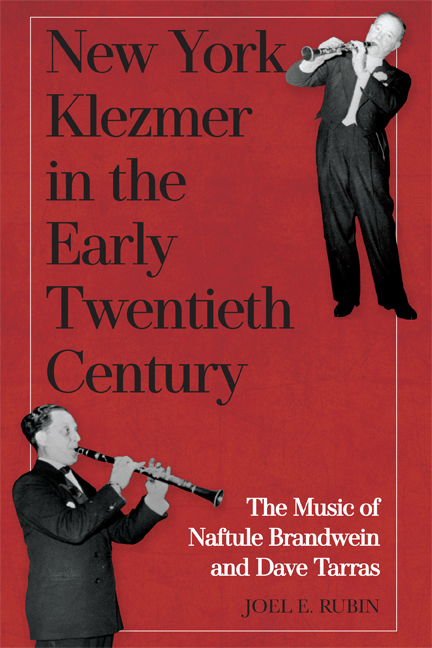Book contents
- Frontmatter
- Contents
- Acknowledgments
- List of Abbreviations
- Note on Orthography and Transliteration
- About the Companion Website
- Introduction: “If You Called Me A Klezmer Thirty-Five Years Ago …”
- 1 A Wedding in Town Was Like a Holiday: A Short History of Klezmorim in Europe
- 2 Klezmer in New York: Changing Meanings, Changing Contexts
- 3 A Kind of “Ethnomusicological Archive”: Commercial 78-rpm Recordings of Klezmer Music
- 4 A Single Field Irrespective of Origin: Polymusicality and Language, Aesthetics, Classification, and Transcription
- 5 “What Mattered Was What’s Happening with the Tune”: Modality and Compositional Processes
- 6 “The Little Things That They Do”: Ornaments and Performance Practice Techniques
- 7 “The Newest Bulgar Out That Everyone Played”: New York Klezmer after 1929
- Glossary
- Notes
- Bibliography
- Index
6 - “The Little Things That They Do”: Ornaments and Performance Practice Techniques
Published online by Cambridge University Press: 11 September 2020
- Frontmatter
- Contents
- Acknowledgments
- List of Abbreviations
- Note on Orthography and Transliteration
- About the Companion Website
- Introduction: “If You Called Me A Klezmer Thirty-Five Years Ago …”
- 1 A Wedding in Town Was Like a Holiday: A Short History of Klezmorim in Europe
- 2 Klezmer in New York: Changing Meanings, Changing Contexts
- 3 A Kind of “Ethnomusicological Archive”: Commercial 78-rpm Recordings of Klezmer Music
- 4 A Single Field Irrespective of Origin: Polymusicality and Language, Aesthetics, Classification, and Transcription
- 5 “What Mattered Was What’s Happening with the Tune”: Modality and Compositional Processes
- 6 “The Little Things That They Do”: Ornaments and Performance Practice Techniques
- 7 “The Newest Bulgar Out That Everyone Played”: New York Klezmer after 1929
- Glossary
- Notes
- Bibliography
- Index
Summary
Ornamentation as a Key Stylistic Characteristic
Ornamentation constitutes an essential attribute of the traditional instrumental styles of eastern and southeastern Europe in general. For example, Timothy Rice writes of the gaida tradition that “ornamental style seemed … crucial to defining the music as Bulgarian or Thracian. If I was going to understand Bulgarian music in general, and gaida playing in particular, I would have to learn more about how these ornaments were produced and what they represented in terms of musical experience.” Sotirios Chianis has commented similarly: “Ornamentation is not an added musical ingredient, it is the very ‘soul’ of all Greek folk music.”
In a similar fashion, it is the manner in which Brandwein and Tarras ornament the tunes in various and subtle ways—in conjunction with the more structural characteristics I discussed in chapter 5—that forms the most characteristic aspect of the performances.
The New Grove defines improvisation as “The creation of a musical work, or the final form of a musical work, as it is being performed.” Improvisation in Western art music, which may include “the ornamentation of a given part or parts,” rests to some extent “upon a series of conventions or implicit rules.” Within this context, ornaments have been characterized as “[t]hose more or less brief and conventional formulae of embellishment which have always been liable to occur within traditions of free ornamentation, and which proliferated in European music of the Baroque period.” From these definitions, individual ornaments may be viewed hierarchically as forming a subcategory of embellishment that is a subcategory of ornamentation (as a general phenomenon) which, in turn, is a subcategory of improvisation.
Bruno Nettl's ethnomusicological definition shows that improvisation is much broader than that, a “vast array of types of creativity, from the choice among two or three ornaments for insertion to presentations of totally ‘free’ improvisatory performance; from repertories consisting entirely of unplanned renditions to musics in which improvisation is limited to brief insertion; from solo to group; and much more.”
The ornaments present in the recordings of Brandwein and Tarras comprise both those which may be seen to be analogous to certain types of baroque ornaments, as well as others that employ such techniques as pitch bending and sliding between tones.
- Type
- Chapter
- Information
- New York Klezmer in the Early Twentieth CenturyThe Music of Naftule Brandwein and Dave Tarras, pp. 175 - 259Publisher: Boydell & BrewerPrint publication year: 2020



